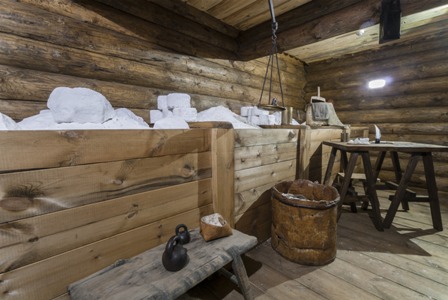Соляной амбар

Соляной промысел на территории Илимского воеводства был основан в
Техника производства соли была тогда очень простой: рассол собирали в многовёдерные железные котлы или большие сковороды — цырены (црены), под которыми разводился дровяной огонь. При нагревании рассола в осадок выпадали сначала гипс и другие примеси, которые удалялись. Выварочная поваренная соль всегда была чище исходного рассола.
Вываренная соль поступала в государевы соляные амбары. Запаса соли должно было хватать как на выдачу годового жалования всем служилым людям, так и на продажу жителям Илимска.
Усть-Кутская варница, превратившейся со временем в солеваренный завод, снабжала государевой солью не только северное Предбайкалье, но и весь громадный Якутский край, достигая пределов государства — Охотска и Камчатки.
SALT BARN
The first brine pit was founded in 1639 on the territory of the Ilimsk Voivodeship by the explorer Yerofey Khabarov. This happened on the salty springs which formed a small lake about three versts (translator's note 1verst =3,500 feet) from the Ust-Kutostrog on the Lena River.
The technique of salt production was very simple at that time: the brine was collected in multi-chamber iron boilers "salgi" or large pans — “tsyrens” (tsren), under which a wood fire was lit. When the brine was heated, gypsum and other impurities would settle down first and then were removed. Boiled table salt was always cleaner than the original brine.
The ready-made salt was delivered to the tsar`s salt barns. The supply had to be sufficient both for the issuance of an annual salt salary to all people in service and also for the retail sale to the residents of Ilimsk.
The salt storage compartments and a workplace of the official who managed salt distribution were reconstructed in the museum.
The Ust-Kutbrine pit, which eventually turned into a salt factory, supplied the tsars` salt not only to Northern Prebaikaliye but also to the entire YakutskRegion, reaching the borders of the Russian state-Okhotsk and Kamchatka.
The Salt Barn exhibition was opened to the public in 2015.
盐库
伊利姆斯基行政区的制盐业是1639年由叶罗费伊·哈巴罗夫探险家创办发展的。
在乌斯季库特区勒拿河岸的盐湖拥有自然的卤水和盐田。
那时候是用锅熬制食盐,在高温之下沉淀石膏和其他的杂质。熬制的食盐比原始盐水纯度更高。
食盐被存放到国有的盐仓。盐库的食盐储藏量足够给所有的军人发放军饷,同时还向伊利姆斯克居民进行出售。
博物馆的盐仓中,重建了食盐储藏室,并重建了管理人工作的地方。
最终,乌斯季库特区的盐田变成了一个大盐厂,不仅为贝加尔湖北边的地区提供食盐,而且向整个广阔的雅库茨克地区提供食盐。
“盐仓”于2015年开始向游客开放。
Заявка успешно отправлена!
Укажите свои данные
мы ответим на ваш вопрос








